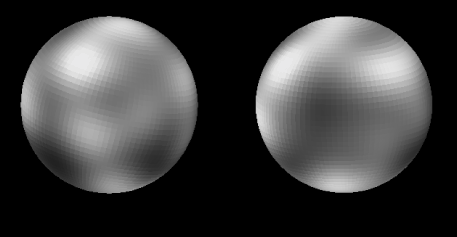Explanation: No spacecraft from Earth has yet explored Pluto but astronomers have found ways of mapping its surface. A stunning map of this distant, diminutive planet, the first based on direct images, was revealed late last week in a Hubble Space Telescope press release. Above are two opposite hemisphere views of the computer constructed map of Pluto's surface (north is up). The grid pattern is due to the computer technique used where each grid element is over 100 miles across. The map is based on Hubble images made when Pluto was a mere 3 billion miles distant. It shows strong brightness variations - confirming and substantially improving upon ground based observations. While the brightness variations may be due to surface features like craters and basins they are more likely caused by regions of nitrogen and methane frost. The frost regions should show "seasonal" changes which can be tracked in future Hubble observations. Yes, Pluto is a planet even though it is only 2/3 the size of Earth's Moon!
Information:
The
Scale of the Universe Debate in April 1996
1999 2000 2001 2002 2003 2004 2005 2006 2007 2008 2009 2010 2011 2012 2013 2014 2015 2016 2017 2018 2019 2020 2021 2022 2023 2024 2025 |
Январь Февраль Март Апрель Май Июнь Июль Август Сентябрь Октябрь Ноябрь Декабрь |
NASA Web Site Statements, Warnings, and Disclaimers
NASA Official: Jay Norris. Specific rights apply.
A service of: LHEA at NASA / GSFC
& Michigan Tech. U.
|
Публикации с ключевыми словами:
Pluto - HST - космический телескоп им.Хаббла - Плутон
Публикации со словами: Pluto - HST - космический телескоп им.Хаббла - Плутон | |
См. также:
Все публикации на ту же тему >> | |
